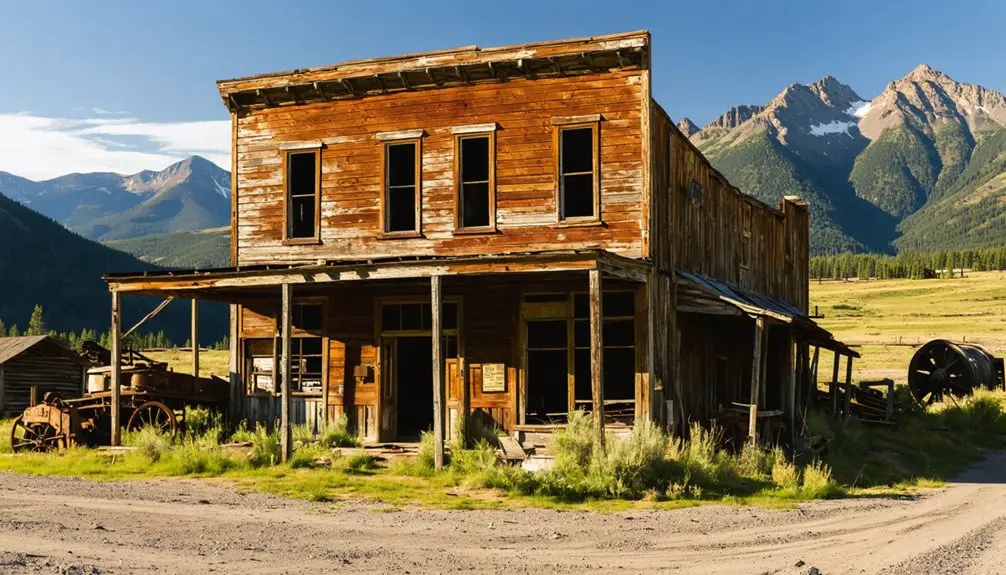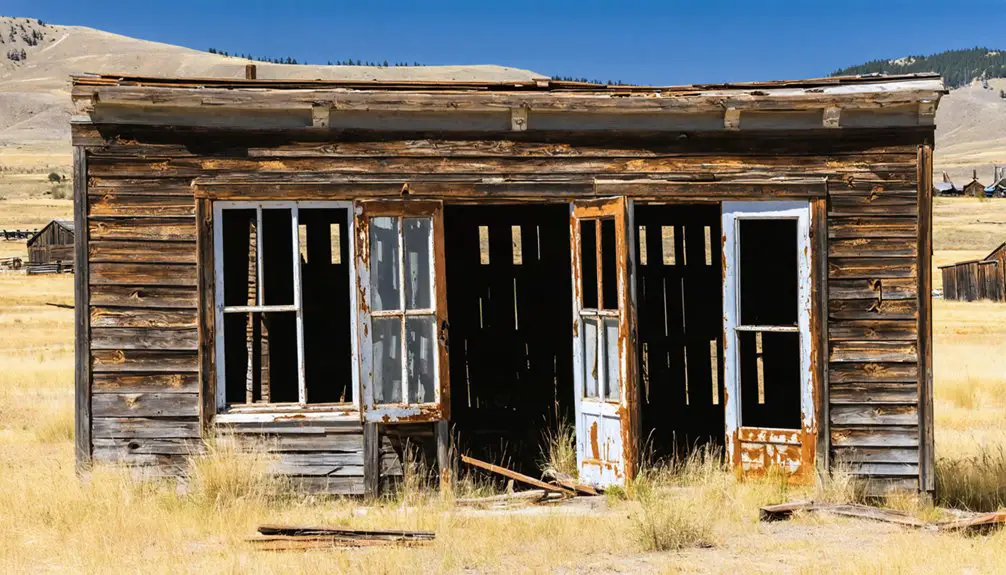You’ll find the old silver mining town of Barker tucked away in Montana’s Little Belt Mountains, about 12 miles east of Monarch. After silver’s discovery in 1879, the town boomed with up to 1,500 residents, a smelter, and eventually a railroad connection. The Block P Mine alone produced 2.5 million ounces of silver before operations ceased in 1943. Today, you can explore the standing cabins and Clendenin Smelter remains while uncovering a rich chapter of Montana’s mining heritage.
Key Takeaways
- Barker ghost town lies 12 miles east of Monarch in Montana’s Little Belt Mountains, featuring remains of the historic Clendenin Smelter.
- Founded in 1879 following silver discoveries along Galena Creek, Barker became a thriving mining community with 1,500 residents at its peak.
- The town experienced multiple boom-bust cycles, with final closure in 1943 after producing millions of ounces of silver.
- Several original cabins still stand at the site, along with the old Hughesville cemetery and scattered mining equipment remnants.
- Visitors can access the ghost town via US-89 and Hughesville Road, but should respect private property and exercise caution around unstable structures.
The Silver Strike That Started It All
When prospectors discovered high-grade silver deposits along Galena Creek in Montana’s Little Belt Mountains during the fall of 1879, they set in motion a mining boom that would shape Judith Basin County’s future.
The first mining camps of Barker and Hughesville emerged as pioneers flocked to the region. This silver discovery prompted swift development, as the rich ore’s potential couldn’t be ignored. By 1881, the newly formed Clendenin Mining and Smelting Company had constructed a smelter near the strike, processing four tons of ore daily at its peak.
You can trace the early mining legacy through their impressive output – the smelter produced $375,000 worth of bullion in just 18 months. A second smelter joined the operation in the early 1880s, though both facilities faced challenges as the easily accessible surface ore began depleting by 1883. The area’s decline accelerated after the Sherman Silver Purchase Act devastated silver prices across Montana in 1890.
Rise of a Mining Powerhouse
After a brief lull in mining activity, Barker’s fortunes surged again in 1890 with rich new strikes at the May and Edna, Liberty, and Wallace mines.
The completion of the Montana Central Railroad branch in 1891 revolutionized ore transportation, connecting you to smelters in Great Falls, Helena, and Neihart. Similar to Fort Benton’s path, an eighty-three-mile route was initially used to transport ore before the railroad’s arrival.
Mining innovations transformed Barker into an economic powerhouse. The Clendenin Mining and Smelting Company‘s local smelter processed four tons of ore daily, producing $375,000 in bullion during its 18-month run.
Barker’s smelter operations processed tons of ore each day, generating substantial bullion wealth in just eighteen months.
When T.C. Power acquired the Block P Mine in 1902, he expanded operations with a gravity mill that processed 100 tons daily by 1920. The mine’s remarkable productivity yielded 2.5 million ounces of silver during its operational years.
The real game-changer came in 1927 when St. Joseph Lead Company installed a 400-ton selective flotation mill, making Barker Montana’s largest lead producer by 1929.
Life in the Boomtown Years
You’d find life in 1890s Barker dominated by the daily rhythms of mining shifts, with workers streaming between the mines, bunkhouses, and fifteen local saloons that served as the town’s primary entertainment venues.
Living conditions centered around communal housing in company bunkhouses and hastily-erected tent cities, while only a small number of proper family homes dotted the mountainside. The steep prices for shipped food staples meant residents often struggled to maintain basic provisions. Together with nearby Hughesville, scattered mining cabins still remain as evidence of the once-thriving settlements.
The social fabric wove together single male miners, merchants, and the occasional family, all connected through churches, fraternal organizations, and the notorious activities at the local brothel.
Daily Mining Town Routines
Life bustled through Barker’s streets during the boom years as miners trudged to their shifts at the numerous silver and lead mines, while wagons loaded with precious ore rumbled toward Fort Benton’s distant port.
Your daily mining routines would’ve centered around the town’s industrial heartbeat – the smelters processing 4 tons of ore daily, and the railroad depot after 1891. Colonel Clendenin built the first local smelter in 1881, transforming how ore was processed in the region.
The town labor was demanding and often dangerous, as evidenced by tragic accidents like Colonel Clendenin’s death in a cave-in. Many miners passed their time reading popular works like Ghost Towns of the Northwest during their off hours.
- You’d work alongside 1,000 fellow residents during the peak years around 1892
- You’d find entertainment at one of 15 saloons after grueling shifts
- You’d witness the constant flow of ore wagons and later, train cars, moving precious metals to distant smelters
Entertainment and Social Life
While miners toiled through grueling shifts underground, Barker’s social scene flourished with diverse entertainment options that brought the community together.
You’d find yourself paying 50 cents to a dollar for dance events featuring refined waltzes and lively Virginia reels. After work, you could head to the saloons where gambling, drinks, and hurdy-gurdy music helped you unwind in true frontier fashion. Much like in Virginia City’s vigilante era, residents gathered at saloons to share stories and news of the day. Similar to the Diamond City boom years, the population swelled with thousands of fortune seekers.
For a change of pace, you’d join baseball games against rival towns, go fishing in nearby streams, or enjoy seasonal activities like ice skating and sledding.
The town’s cultural life included traveling theater troupes, circus shows, and variety performances. When you weren’t catching a show, you could test your skills at the bowling alley or participate in community spelling bees.
Living Conditions and Housing
Beyond the social gatherings and entertainment venues, Barker’s housing landscape painted a stark picture of frontier practicality. You’d find yourself living in crowded bunkhouses or tent cities, where mining companies prioritized function over comfort.
With a peak population of 1,500 residents, housing structures primarily served the transient male workforce, offering basic shelter from Montana’s harsh elements.
- Your daily life would’ve meant sharing cramped quarters with fellow miners, with minimal sanitation facilities.
- You’d have access to only basic amenities – a general store and chapel stood as the town’s few permanent fixtures.
- While the majestic mountain views surrounded you, your living conditions remained austere, with simple wooden structures or canvas tents as home.
These pragmatic dwellings, though lacking in sophistication, embodied the rugged spirit of frontier mining life.
Railroad’s Arrival and Impact

After years of relying on horse-drawn wagons and mule trains, Barker’s mining district received a transformative boost when the Montana Central Railroad extended its branch line to the town in 1891.
This railroad infrastructure connected Barker’s mines directly to smelters in Great Falls, Helena, and Neihart, sparking a mining revival that saw rich strikes in the May, Edna, Liberty, and Wallace mines.
You’ll find that Barker’s economic dependency on the railroad became clear as it enabled profitable lead mining operations and ore shipments beyond local markets.
The rail connection sustained the district through the 1890s, though the Silver Panic of 1893 dampened activity.
The Slow Fade Into History
The slow unraveling of Barker’s prosperity began well before the railroad’s departure, traced back to 1883 when surface ore deposits showed signs of depletion.
Despite the community’s resilience through brief revivals in 1890 and later industrial expansions, economic decline proved relentless.
You’ll find evidence of Barker’s struggle for survival in these defining moments:
- The devastating Silver Panic of 1893 forced most mines to close, leaving only slag dumps and tailings to process.
- Population swings from 500 to nearly zero by 1904, then back to 500 in 1929, reveal the town’s vulnerability.
- The final blow came in 1943 when mining operations ceased permanently, though you can still spot vintage cabins and mining structures on private land today.
Exploring the Ghost Town Today

Whether you’re drawn to Montana’s mining heritage or simply enjoy exploring remote historical sites, visiting Barker today offers a genuine glimpse into the state’s frontier past.
You’ll find this ghost town about 12 miles east of Monarch in the Little Belt Mountains, accessible via US-89 and Hughesville Road.
As you explore, you’ll encounter several standing cabins and the remains of the Clendenin Smelter, though ghost town preservation efforts remain minimal to maintain authenticity.
For visitor safety, stay alert around unstable structures and respect private property boundaries, particularly near the St. Joseph Company’s mining buildings.
The old Hughesville cemetery and scattered mining remnants tell silent stories of the area’s 500 former residents.
Remember to take only photographs and leave the historical artifacts undisturbed for future explorers to discover.
Frequently Asked Questions
Are There Any Documented Supernatural Occurrences in Barker’s Abandoned Buildings?
You’ll find ghost sightings in Barker’s old buildings primarily center around eerie legends of phantom phone calls, mysterious voices, and that haunting little girl who appears to female hikers near Bear Canyon.
What Happened to the Mining Equipment After the Operations Ceased?
You’ll find tons of equipment was simply abandoned on-site, while some got sold off during brief revivals. Without railroad transport after 1903, disposal methods were limited and equipment restoration became impractical.
Did Any Famous Outlaws or Notable Historical Figures Visit Barker?
You won’t find any famous visitors or outlaws in Barker’s historical record. Unlike other Montana mining towns with colorful outlaw legends, Barker’s historical significance remains tied purely to mining operations.
What Was the Average Wage for Miners Working in Barker?
You’d have earned around $3.50 per day as a miner in Barker during the early 1900s, facing tough historical mining conditions despite rising copper prices that didn’t translate to higher wages.
Were There Any Major Accidents or Disasters in Barker’s Mining Operations?
You won’t find records of major accidents specific to Barker’s mines, though the area faced similar risks as nearby Butte, where mine explosions led to stricter safety regulations across Montana’s mining districts.
References
- http://berkeleyprize.org/endowment/the-reserve?id=176
- https://www.legendsofamerica.com/mt-ghosttowns/
- https://www.ghosttowns.com/states/mt/hughesville.html
- https://www.legendsofamerica.com/mt-barkerhughesville/
- https://www.ghosttowns.com/states/mt/barker-hughesville.html
- https://www.teenink.com/nonfiction/academic/article/681175/Silver-Mining-in-Montana
- https://cfwep.org/clark-fork-info/history/1860s-gold-silver-and-early-mining/
- https://mhs.mt.gov/Shpo/AfricanAmericans/History/Timeline
- https://www.blm.gov/sites/default/files/docs/2021-07/THE ROAD TO GARNET’S GOLD (002).pdf
- https://westernmininghistory.com/mine-detail/10089197/



